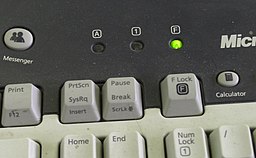
The F-Lock key, introduced by Microsoft in 2001, toggles the state of the function keys. When on, keys F1 to F12 behave as applicable, with meanings defined by the application being used at the time. When off, new behaviour is used: F5 means "open", F10 means "spell" etc. In early models, the state reverted to off at each reboot or keyboard reset, but later models retained F-Lock state across reboots.
Other keyboard manufacturers (such as Logitech and Viewsonic) have also implemented the F-Lock onto their keyboards.
Issues
The introduction of F-Lock was marked by criticism on several points. First, the behaviour was unintuitive: pressing a key such as F4 by default no longer had its normal meaning, so combinations such as Alt+F4 appeared not to work.
Secondly, the choice of secondary function assigned to each key appeared to be arbitrary: whereas F7 was the traditional key for spell-check (used notably by Microsoft itself in its Office products), F7 was assigned the function of "reply", and spell-check was assigned to F10. This caused strong criticism from some commentators.
Pressing F2 in Windows Explorer in attempt to rename a file would instead undo an earlier file operation, with potentially disastrous consequences if the actual effect went silently unnoticed.
Because of such concerns, a number of methods for disabling the F-Lock function appeared on the web.
Many Windows/PC users have found a workaround using Microsoft's Intellitype Pro software, which allows a user to assign keystrokes/macros to the function and accessory keys. For example, assigning a macro {Press F1} to the function key F1 renders the F-lock issue moot, since the OS will interpret the key press as F1 regardless of the F-lock state.
Functions
The new behaviours assigned to the keys are as follows:
| Key | New behaviour |
|---|---|
| F2 | Undo |
| F3 | Redo |
| F4 | New |
| F5 | Open |
| F6 | Close |
| F7 | Reply |
| F8 | Forward |
| F9 | Send |
| F10 | Spell |
| F11 | Save |
| F12 |
External links
- Yong Shu Chiang (2001-10-16). "Microsoft Office Keyboard". CNET Asia. Archived from the original on 2006-02-14. Retrieved 2008-11-21.
- For example, .
- Jason Tsang. "Microsoft Keyboards - F Lock Key". Archived from the original on 2008-11-09. Retrieved 2008-11-21.
| Keyboard keys | |
|---|---|
| Dead keys | |
| Modifier keys | |
| Lock keys | |
| Navigation keys | |
| Editing | |
| Contextual | |
| Misc. | |